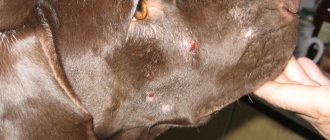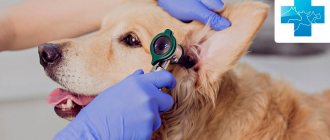The kidneys are the body's most important cleansing system for removing toxins and other harmful substances. That is why any “problem” of this organ greatly affects the dog’s health.
Since pathological processes in the kidneys develop very slowly, the owner of the animal most often notices the presence of problems in his pet quite late. To stop the disease in the early stages and have time to help your dog stay healthy, you need to be attentive to any, even very minor, “bells” signaling that something is wrong with your pet.
We will tell you about the manifestations of such a complex disease as renal failure in dogs, its diagnosis and treatment tactics.
What is this?
Renal failure (RF) is a pathological condition of the body in which the functioning of the kidneys is partially or completely impaired. This inevitably leads to problems with the excretory system, water-salt balance, blood circulation and blood pressure, as well as internal organs.
The risk group includes pets over 5 years of age (in the absence of provoking factors at an earlier age). In this case, you need to be especially careful if your dog belongs to one of the following breeds:
- shih tzu,
- samoyed dogs,
- english cocker spaniels,
- german shepherds,
- bull terriers,
- golden retrievers.
Kidney cells and tissues are not restored, so the diagnosis and treatment of the disease must be approached as carefully as possible, entrusting this task to experienced veterinary specialists.
Causes
In 20% of cases, the cause of kidney failure in dogs cannot be determined. This is due to the fact that owners do not know about possible provoking factors, and the disease is detected already in the last stages of development.
Among the most common reasons:
- Hereditary diseases
Amyloidosis and polycystic disease cause difficulty with kidney function in young dogs. This is caused by the accumulation of abnormal white structures and the formation of many cysts filled with fluid.
- Infections
Leptospirosis, Carré's disease, viral enteritis or hepatitis are just some of the acute infectious diseases that can trigger the development of kidney failure. This is due to the fact that pathogenic microorganisms penetrate the renal tissue, disrupting the functioning of the kidneys.
- Functional disorders
Certain diseases can cause kidney damage and pathological changes, provoking the development of renal failure. Among them: glomerulonephritis (glomerular nephritis), pyelonephritis, nephritis, nephrosis, etc.
- Parasitic infestation
Piroplasmosis and hemobarthenelosis destroy and also block the activity of red blood cells, exerting a toxic effect on the entire body as a whole. As a result of the release of toxins, the kidneys gradually lose functionality, so their work is disrupted.
- Intoxication of the body
Severe poisoning is a common cause of kidney failure among dogs of various ages and breeds. Most often it occurs when consuming household pesticides, medications, salts of heavy metals, etc.
- Diseases of the urinary system
The development of liver failure in dogs can be provoked by the most common disease of the urinary system - urolithiasis (UCD), since it is accompanied by compression or complete blockage of the urinary tract.
- Other reasons
Other factors can lead to kidney failure: benign and malignant tumors, cysts, severe bleeding with a sharp drop in blood pressure, congenital underdevelopment of organs, etc.
How does kidney failure manifest in dogs?
Detecting signs of kidney failure in dogs in the early stages is problematic. Typically, the first signs appear when about 65-70% of the kidney tissue is no longer functioning. The remaining part is not able to cope with the secretion and purification of blood, which entails various disturbances in the functioning of the body.
Signs of kidney failure in dogs:
- I (latent)
The longest period of development of renal failure. The animal's activity, mobility and appetite are normal. There are no abnormalities or symptoms of the disease. The disease can be diagnosed only by taking tests, since the level of creatinine in the blood will be no more than 125 mmol/l.
- II (compensatory)
The main signs are constant thirst and frequent urination. By the end of the compensatory stage, about 50% of the structural and functional units of the kidney (nephrons) die. The level of creatinine in the blood ranges from 125 to 180 mmol/l.
- III (decompensation)
Other signs are added to problems with urination: loss of appetite, sudden weight loss, constant weakness and lethargy, problems with the gastrointestinal tract. By the end of this stage, no more than 20% of nephrons are functioning. The level of creatinine in the blood is from 180 to 440 mmol/l.
- IV (terminal)
The most difficult period of illness, associated with severe intoxication of the whole body, electrolyte imbalance, and poor health. No more than 15% of nephrons continue to “work”, while the level of creatinine in the blood exceeds 440 mmol/l.
Diagnostics
As we have already noted, the primary stage of the disease does not have pronounced symptoms, and it is difficult to determine it using laboratory tests, since the kidneys are still doing their job well, despite the changes that have begun in them.
When the clinical stage approaches, a blood test for urea and creatinine reveals an increase in these indicators, and this is what makes it possible to understand that the dog has diseased kidneys.
If you have even the slightest suspicion that your pet has kidney problems, then you need to periodically take tests to determine the level of urea and creatinine and, if they approach the upper limit of the norm, discuss further actions with your veterinarian.
Forms of renal failure: acute and chronic
The nature of the manifestation of symptoms of renal failure in your pet depends directly on the form of the disease - acute or chronic. All signs differ in the brightness of the current and the speed of occurrence.
Chronic renal failure (CRF) usually occurs in adult dogs. It develops slowly but constantly. Before characteristic symptoms appear, the kidneys may lose 3/4 of their functions. The main symptom is extreme thirst, among other symptoms:
- ammonia odor from the mouth,
- dehydration,
- dry mucous membranes,
- dullness of fur,
- viscous saliva,
- decrease in body temperature to 37 °C,
- severe swelling,
- bradycardia,
- lack of appetite.
Note! The more nephrons are lost, the more severe the symptoms of kidney failure in dogs develop and manifest.
Acute renal failure (ARF) is characterized by the rapid onset of symptoms. It is clearly visible and complex, so the owner immediately notices that the dog’s condition has worsened. Among the main signs:
- a sharp deterioration in general condition,
- muscle weakness,
- urinary disturbance
- elevated heart rate,
- swelling,
- blanching/redness of mucous membranes,
- formation of ulcers in the mouth,
- complete refusal to eat.
Does your dog have a similar symptom pattern? Make an appointment with your veterinarian immediately. The sooner you seek professional veterinary help, the sooner your beloved pet will regain its appetite, mobility and good mood!
Periods of development
The mechanism of the disease syndrome is easier to understand when each subsequent stage is clearly explained.
There are:
- Compensation.
The period is insidious, long, and takes up almost 90% of the time the disease develops. There are no symptoms, the pet appears healthy. A timely urine test helps to recognize the problem earlier.
- Hidden.
It is characterized by an increase in functional renal disorders, but without going critical; everything is clear; a urine test may show partial changes in kidney function. Diagnosis is made by ultrasound.
- Decompensation.
The epiphany stage is where the first symptoms of renal failure appear. Urinalysis is bad.
- Terminal.
Critical stage, kidneys practically do not work. The likelihood of developing renal coma is high. The syndrome is divided into prerenal, renal and postrenal types. Each of them has its own processes that lead to pathological functioning of the kidneys.
Prerenal, develops as a response to insufficient blood supply to the paired organ, often when using poor quality anesthesia.
Renal, often occurring, occurs when the kidneys are exposed to viruses, bacteria, toxins, and poisons.
Postrenal, observed in old dogs, with urolithiasis, helminthic infestation, obstruction of the bile ducts.
Fact! CRF develops with prolonged exposure to pathological factors on kidney tissue. The nephrons die, the organ ceases to function normally.
Effective treatment
Treatment of acute and chronic renal failure in dogs is carried out in several directions. Regardless of the stage of the disease, infusion therapy (droppers) with medications that support the general functioning of your pet’s body is prescribed.
Note! Medicines and their dosage can only be prescribed by a veterinarian after an accurate diagnosis.
Drugs used:
- Infusion solutions (100-400 ml). They restore the balance of salts, alkalis and acids. They have a detoxifying, anti-shock and alkalizing effect. They are administered intravenously, but subcutaneous administration is allowed in puppies;
- Diuretics . Depending on the specific drug, the rate of fluid removal from the body is regulated by increasing/decreasing the Na concentration. They are used intramuscularly, intravenously or by drip;
- Antiemetic drugs . They soothe the gastrointestinal tract, relieving nausea and preventing vomiting. Quickly relieve vomiting symptoms. Used in solution or tablet format;
- Phosphorus binders . They are used to improve the condition of the stomach of dogs and have a sorbing effect. Some drugs have a pronounced detoxifying effect;
- Drugs to normalize cardiac activity . They are used if the functioning of the cardiovascular system has been impaired as a result of renal failure. The drugs stimulate the central nervous system, have an antiarrhythmic effect and tone up the heart.
Do not try to prescribe treatment for your pet at home. Only in a veterinary clinic will it be possible to restore the functioning of the kidneys and prevent the further development of acute or chronic renal failure!
Symptoms of chronic kidney disease
Pathology cannot be detected at the very beginning, because there are no external symptoms at the initial stage if the disease is chronic. They appear only when one kidney stops functioning and the disease enters the clinical stage.
Symptoms can appear several at a time, or some individually.
Then clear symptoms appear:
If measures are not taken, the dog becomes dehydrated and urine disappears as a result.
Convulsions may begin, ulcers appear in the mouth, vomiting of undigested food and a coma, resulting in death.
Nuances of nutrition in renal failure
Proper nutrition for a dog with kidney failure prevents the condition from worsening and the progression of the disease. It is recommended to exclude vegetable oils from the diet, while animal fats are not contraindicated. Vegetables should not be given raw: they must first be boiled and then crushed into puree.
It is necessary to exclude all foods rich in phosphorus:
- fish,
- bones,
- eggs,
- oatmeal,
- millet,
- barley,
- pumpkin,
- green beans, etc.
Kidney failure in a dog is a serious disease that remains virtually asymptomatic for a long time. To prevent dangerous consequences, it is recommended to periodically check with a veterinarian and conduct an ultrasound of the internal organs.
Timely treatment of renal failure will save your pet's life and provide reliable support for the functioning of the kidneys!
Caring for a sick dog
Caring for a sick pet mainly consists of proper nutrition and regular use of medications prescribed by the doctor.
The food must be balanced. You can use ready-made medications, but consult your veterinarian before doing so.
You can also cook yourself. The main food requirements: no salt and limited amount of protein. The water should be filtered, not tap water.
With proper treatment and care, the pet can live for a long time.
Meat products are good for dogs during the recovery period











